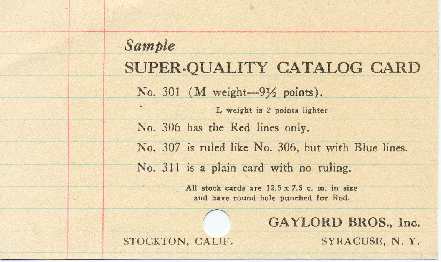- Nov 2025
-
www.instagram.com www.instagram.com
- Feb 2024
-
Local file Local file
-
, one of the reasons that the New York Public Library had toclose its public catalog was that the public was destroying it. TheHetty Green cards disappeared. Someone calling himself Cosmoswas periodically making o� with all the cards for Mein Kampf. Cardsfor two Dante manuscripts were stolen: not the manuscripts, thecards for the manuscripts.
-
book at a public phone rather than bothering to copy down anaddress and a phone number, library visitors—the heedless, thecrazy—have, especially since the late eighties, been increasinglycapable of tearing out the card referring to a book they want.
The huge frozen card catalog of the Library of Congress currently suers from alarming levels of public trauma: like the movie trope in which the private eye tears a page from a phone
-
Radical students destroyed roughly ahundred thousand cards from the catalog at the University of Illinoisin the sixties. Berkeley’s library sta� was told to keep watch overthe university’s card catalogs during the antiwar turmoil there.Someone reportedly poured ink on the Henry Cabot Lodge cards atStanford
-
They donot grow mold, as the card catalog of the Engineering Library of theUniversity of Toronto once did, following water damage.
-
“Atthe end of this project,” Dale Flecker told me, “there won’t be cardcatalogs left in the university.” I asked him if there were any cardcatalogs, anywhere in the world, that he thought worthy ofpreservation. “In general, they’re being discarded,” he said. “I’m notsure I know of anybody who’s decided to preserve them as physicalobjects.” Maureen Finn said much the same thing to me: “Theinstitutions still want the cards back, and then I think they’re storingthem. But most library managers that I talk to will say, ‘We arestoring them because it makes the sta� feel good, and we will begetting rid of them.’ ”
Interesting psychology being played out here....
-
And some undetermined but large fraction of thetotality is being sent to an artist named Thomas Johnston, atWestern Washington University.
Card catalog cards being repurposed for art.
-
OCLC owns the largestdatabase of bibliographic information in the world, and it o�ers aservice called RETROCON, contracting with libraries to transfer oldcatalog cards to “machine-readable form,” at anywhere from �ftycents to six dollars per card.
-
An image of the front of every card for Widener thus now exists onmicro�che, available to users in a room o� the lobby. (Anyinformation on the backs of the cards—and many notes do carryover—was not photographed
-
The cards datingfrom 1911 to 1975 at the New York State Library in Albany (whereMelvil Dewey was librarian from 1889 to 1906) were thrown awaylast month as a consequence of a historical-preservation projectinvolving the building in which they were stored.
Sad that a "historical-preservation project" resulted in the loss of such an interesting historical artifact.
-
cards printed by theLibrary of Congress, Baker & Taylor, and OCLC;
In the 21st century, many library card catalog cards were commercially printed by OCLC, Baker & Taylor, and the Library of Congress
-
Chancellor Edward N. Brandt, Jr., wearing ared T-shirt that said “The Great Discard,” chose a drawer of thecatalog and pulled it from the cabinet. With the help of a beamingCyril Feng, who was then the director of the library, he drew theretaining rod from the chosen drawer and let its several hundredcards ceremonially spill into a trash can decorated with coloredpaper.
The intellectual historian in me: 😱
Tags
- XXI
- Edward N. Brandt Jr.
- Mein Kampf
- RETROCON
- Thomas Johnston
- OCLC
- bibliographies
- vandalism
- theives
- New York Public Library
- Widener University
- Melvil Dewey
- Library of Congress
- retcon
- scanning
- publishing
- art
- collage
- note collection loss and damage
- Cyril Feng
- vandals
- card catalog rods
- historical preservation
- digitization
- manuscript studies
- The Great Discard
- library card catalog cards
- Dante Gabriel Rossetti
- upcycling
- microfiche
- theft
- Baker & Taylor
Annotators
-
-
news.virginia.edu news.virginia.edu
-
The information neatly typed on the cards – which library workers sometimes supplemented with handwritten notes on front and back – includes details that in many cases are not typically part of the electronic catalog system, Virgo, that the University Library switched to in 1989. At the time, the catalog was transferred by scanning that captured only the front of the cards.
Libraries may have handwritten notes on the back of library card catalog cards in the 20th century, a practice which caused data loss in the case of the Alderman Library which only scanned the front of their cards in 1989 when they made the switch from physical cards to a digital catalog.
-
-
www.primasoft.com www.primasoft.com
-
https://www.primasoft.com/help/print_library_catalog_cards.htm
Software for printing library catalog cards. Small Library Pro being replaced by Handy Library Manager
-
-
www.librarything.com www.librarything.com
-
https://www.librarything.com/topic/85852
People circa 2010 interested in exporting their Library Thing book data to print out on library card catalog cards.
(I'm not the only one...)
-
-
www.indiamart.com www.indiamart.com
-
https://www.indiamart.com/proddetail/library-catalogue-cards-23374811530.html
IndiaMart.com still selling 3x5" library catalog cards predrilled. Listing for 1,200 R for 1000 cards.
-
-
www.libraryhistorybuff.org www.libraryhistorybuff.org
-
sample catalog card included in a Gaylord Brothers supply catalog.
Gaylord Bros. sold several types of card catalog cards including:
- No. 301 medium weight
- No. 306 with red rules (classical three lines)
- No. 307 with blue rules
- No. 311 pain card
all were predrilled with holes

-
-
www.demco.com www.demco.com
-
https://www.demco.com/demco-reg-permalife-catalog-cards
The old school Library of Congress card catalog cards with the red ruling.

-
-
www.blyberg.net www.blyberg.net
-
www.ihearofsherlock.com www.ihearofsherlock.com
- Jan 2024
-
www.avery.com www.avery.com